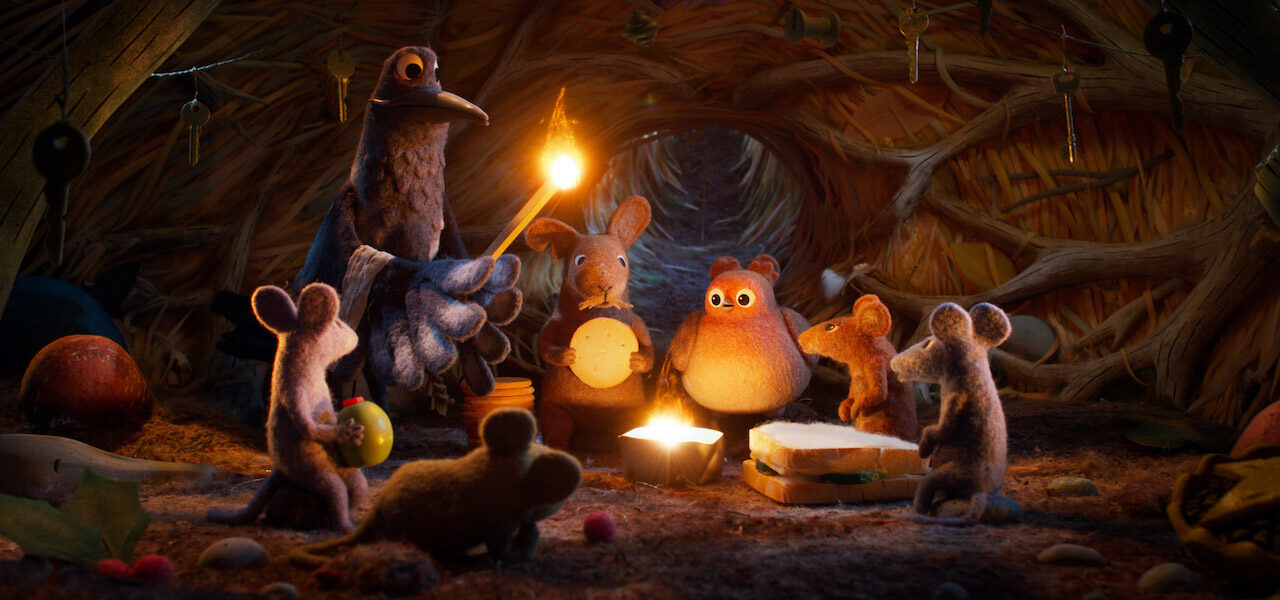
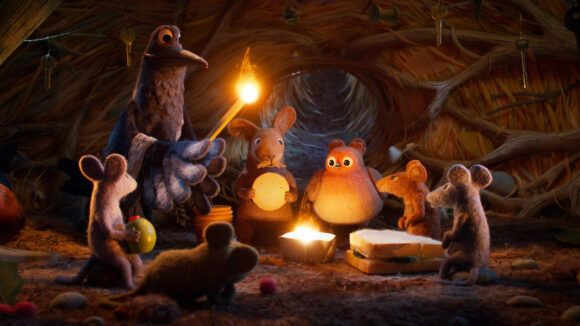
The Directors Of ‘Robin Robin’ Explain How They Broke With Aardman’s House Style
This weekend, Christmas came three months early — and one year late — to London. Robin Robin, a new holiday short from stop-motion stable Aardman (Wallace & Gromit, Chicken Run), premiered at the London Film Festival, following a Covid-induced delay. It was worth the wait.
Robin Robin, which tells the story of a robin raised by mice, represents several novelties for the storied British studio. This is its first musical and its first original production for Netflix (although the streamer previously released A Shaun the Sheep Movie: Farmageddon in the U.S.).
Unusually for Aardman, the half-hour film was created and directed by studio newcomers: Dan Ojari and Mikey Please. Rather than follow the studio’s trademark style — plasticine puppets, broad facial expressions, and so on — the pair conceived a look of their own, embracing fuzzy needle-felt textures and soft, seasonal lighting.
Ojari and Please studied at London’s Royal College of Art, where they both directed remarkable metaphysical stop-motion shorts about humans’ experience of time: Please’s BAFTA-winning The Eagleman Stag and Ojari’s Sundance-playing Slow Derek. After graduating, they formed Parabella Studios and did commissioned work — including a deliriously fun food-based spot for reality show The Great British Bake Off — while developing personal projects.
One of those projects, Robin Robin, took flight in 2018, after Ojari and Please sang a song they’d written for it to an Aardman executive. She was charmed, and the short was greenlit and set up at Netflix. Ahead of its launch on November 24, we spoke to the directors about how they came to make this most unusual of Aardman films, and how the pandemic helped them along the way …
Cartoon Brew: How did you pitch Robin Robin to Aardman?
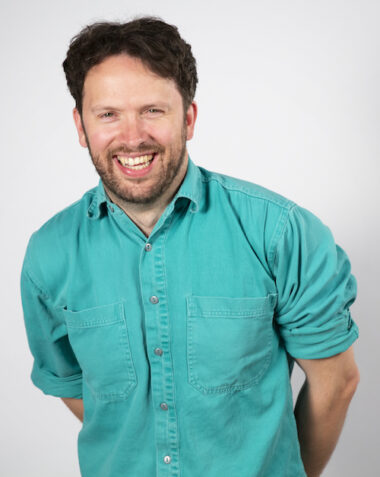
Mikey Please: We pitched it at Annecy Film Festival in 2018. We’d gone there with a pilot that we’d made [for series Alan the Infinite], and Robin Robin as a kind of back-pocket idea. We bumped into [executive producer] Sarah Cox in the canteen. So it was very, very serendipitous, the meeting.
We presented her with this very, very simple story-book-format version of Robin Robin. We’d written Magpie’s song at that point and sung to her in the canteen. She wasn’t put off by that. She was really excited by the fairy-tale nature of [the project].
She took it back to Aardman, pitched it to Pete [Lord, studio co-founder] and the sort of creative council here, they liked it too. So then we came to Aardman. We bought with us lots of fuzzy-felt, needle-felt Christmas decorations and did a proper pitch. And then they optioned it, and then we took it to Netflix and Alexi Wheeler [director of kids and family content, EMEA].

Dan Ojari: What we showed to Sarah was a storybook synopsis, which we’ve done for a few of our ideas, which is just like a really sort of visual and simple way of telling the story. We also had the first draft of the script, which is wildly different from what we ended up making. We’d also worked with an illustrator, Briony May Smith … to create some concept art.
How did the development process work? Was the “creative council” closely involved?
Please: Yeah, we had various “touchstone moments” with them. Sarah Cox was very involved in the development. We worked very closely with Sam [Morrison, co-writer] on the screenplay. We had one fantastic session watching the animatic with Nick Park, who gave some very insightful feedback.
Ojari: One thing that’s worth mentioning: [it was] Aardman and Netflix. I think that they sort of align on this approach to filmmaking: putting a lot of trust in the creators, because with that trust, you then take responsibility for how good it is on yourself. There were lots of really helpful notes from Aardman, but there was never any pressure to act on them. And the same with Netflix.
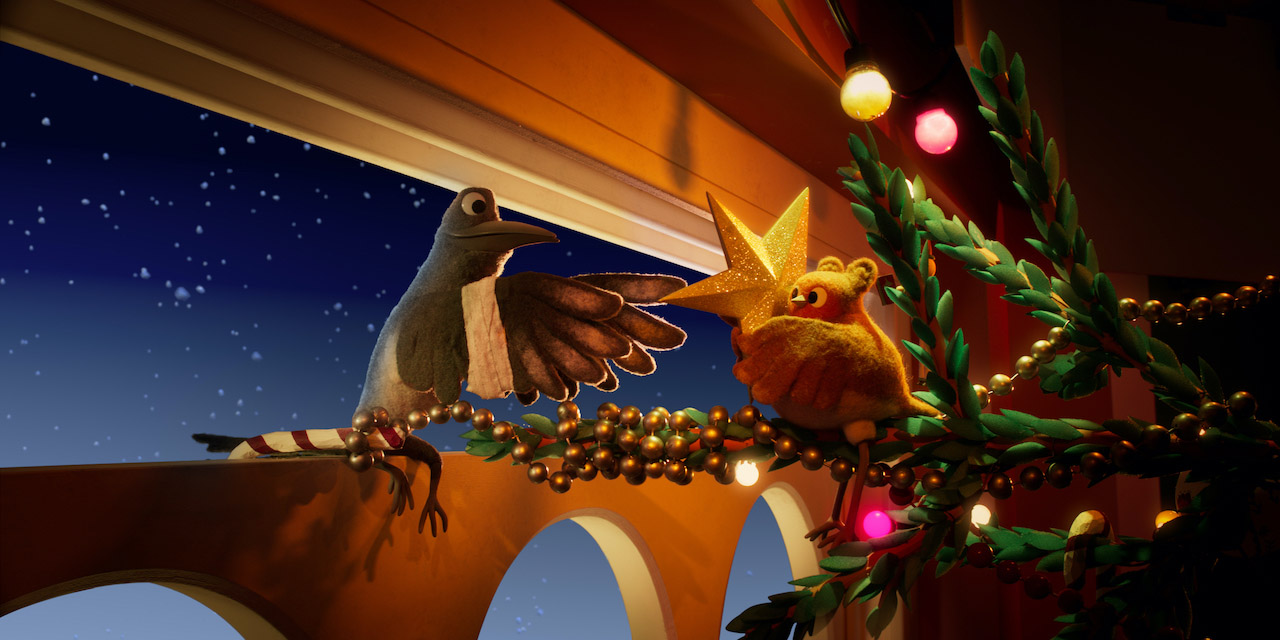
How do you divide creative responsibilities between the two of you?
Ojari: I do act one, part of act two.
Please: And I take part of act two and just see it through to the credits. [Laughs]
Ojari: It’s very fluid.
Please: It’s a Wild West. It’s whoever’s volume is louder during the discussion. Obviously we’ve been working together for a very long time, and when we were on smaller productions — we’ve always worked completely together on the conceptual and the writing structure side.
When it came to production, there would sometimes be an easier divide between areas of focus. But coming to work at Aardman, we’ve come to be part of this absolutely incredible, amazing team. So that divide isn’t really relevant anymore. We were both really across everything. When it came to directing on the floor — handling shots — we did kind of split the film into two, and we would take more focus on particular areas of the film. It wasn’t mid-act two, but …
Ojari: It was a little bit like that, wasn’t it? The structure at Aardman, and I think in other stop-motion productions, is that if you’ve got two directors, which is quite common, you sort of have your own scene. Because having two people executing every shot would get confusing.
One of the strengths in having two people doing, in a sense, one role is that, in order to figure stuff between each other, you have to vocalize it and externalize it. It has to be a clear thing for us both to understand … So then when you communicate it to someone else, you know it’s got a clarity to it and a logic.
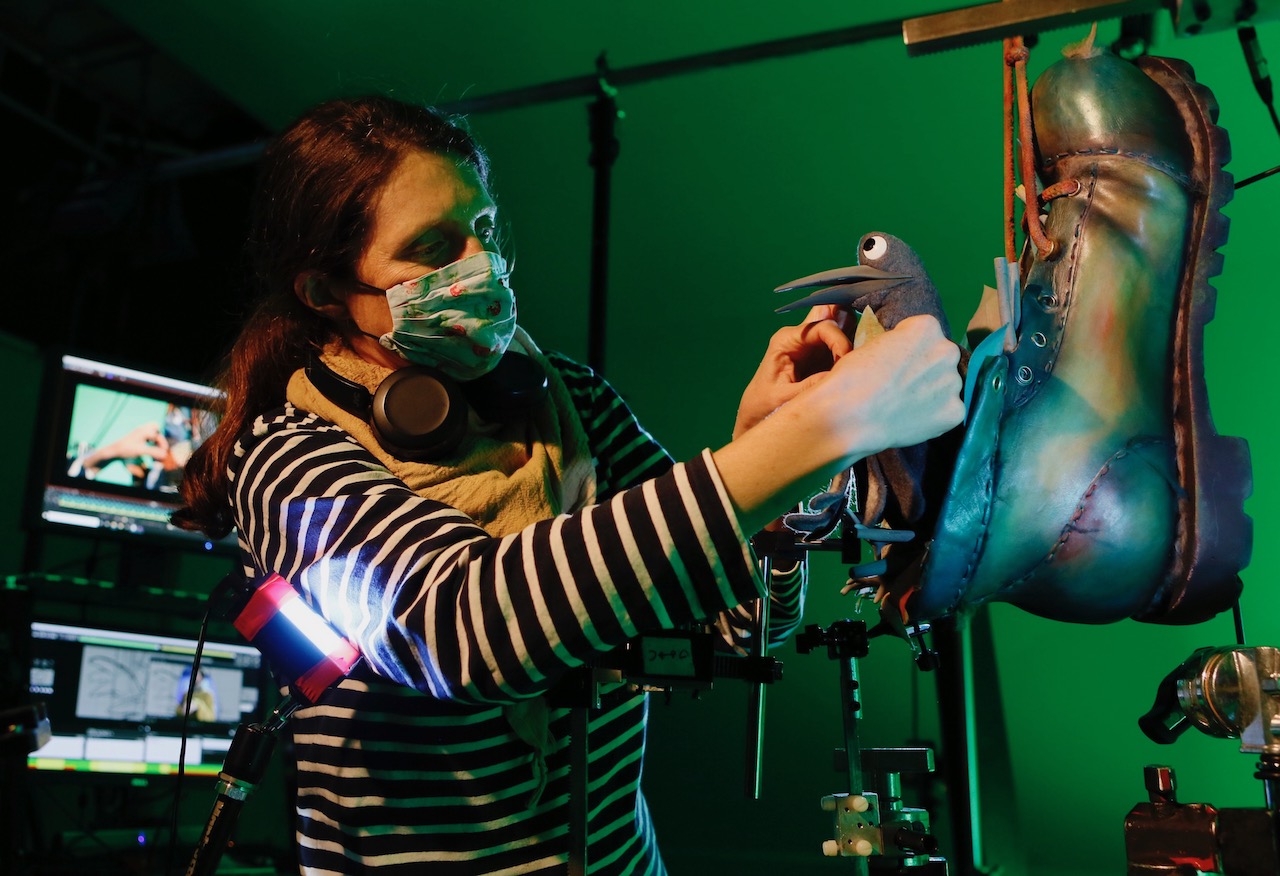
There’s an Aardman house style, which is a kind of combination of Nick Park’s and Peter Lord’s styles: plasticine puppets, etc. Was it clear from the beginning that your film would deviate from that?
Ojari: [Initially,] we didn’t know the ins and outs of Aardman and the way they’d want to push it. We were like, “We wonder if they’re going to push the in-house look on it. It’s not something that we do naturally, but, you know, it’s kind of interesting.” But then to come here and see that, actually, the spirit of Aardman is just passionately trying to make interesting, odd things. Everyone here was welcoming [and open to] trying something out, trying a new venture.
What do you like about felt? Had you used it before in animation?
Please: Not in a central way. It’s a beautiful material to work with. Obviously, there’s a huge, growing body of felt stop-motion [animation], lots of amazing artists working in that way.
It has a lot of similar qualities to plasticine, in that you can sculpt and it has that immediate, tangible visceralness, which is what you want when you’re going to the pains and efforts of making a stop-motion film. You want it to be unmistakable, what you’re actually doing.
There’s also something lovely about the way that felt absorbs light. Having worked with that plastazote material [in the past], one of the things we loved about it was that you could sort of hit it from the back with a strong light, and the whole thing would kind of glow through. Felt has a similar quality to it, in that there’s a sort of numinosity that glows out of felt — you get these beautiful rim lights.
There’s also something [about felt] that felt tonally right for the kind of film, in that it’s a very wool-soft, squeezable material. You could hang it on a tree at Christmas.

Did you watch any of this body of felt stop motion for reference, or did you speak to any of the directors? I’m thinking Oh Willy…, that kind of stuff.
Please: There were lots of artists [at Aardman] who’d worked with felt before. And obviously we did a lot of research and development into how to make them, you know, bendy without them feeling like their skins are stretching. Felt isn’t innately stretchy, but if you clad the body in the right way, it can feel as though it’s one solid thing.
Obviously, we’re huge fans of Marc [James Roels] and Emma [de Swaef, directors of Oh Willy…]. And you’ve got other practitioners. They’re all peers.
Ojari: I remember when we screened This Magnificent Cake! [by Marc and Emma] — incredible. Needle felt is a material, but those films, they have their own set of rules for how they use that material. You could say [Robin Robin] is another needle-felt film, but the way we use it, I think, is quite different, really. A part of it is how much boil, and how loose it is.
We actually went quite clean with it. We used the texture and the way it lights. There’s an element of boil to it, when you’re touching it, but it was a considered amount. We did tests [to see what happens] if you just don’t care about where you touch it or anything, and just let it boil. But it can be quite wild. For certain intimate scenes, it kind of steals the show.
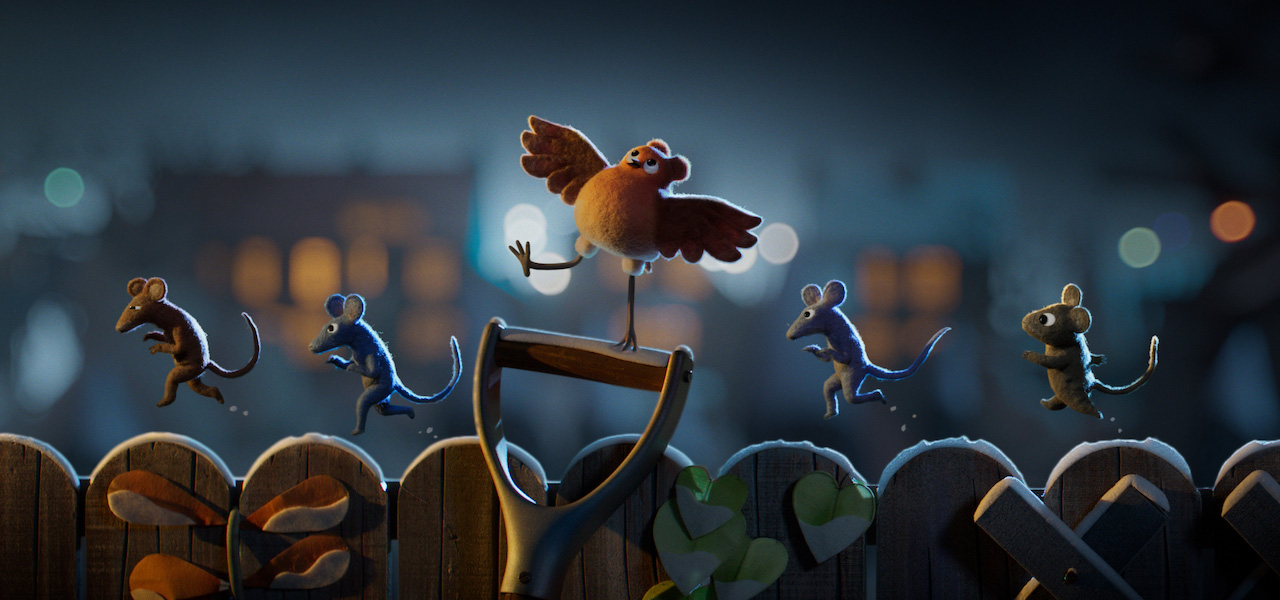
You were saying that the puppet makers and the animators had experienced working with felt already? Were you specifically casting people who did?
Please: Yeah, we brought in a couple of needle-felt experts.
Ojari: I think we even got some people who run needle-felting workshops. There’s loads of interesting techniques … really beautiful, intricate techniques that you can use with needle felt.
Please: It can almost feel photorealistic with some rendering. You can do pinpoint work. We were working from Matt Forsythe’s production art, which is very painterly, lots of hues overlapping. We wanted to push the look and the use of the felt in that way.
Ojari: And also the simplicity of the character design. We did a lot of tests, doing really intricate rendering of the characters, rendering each one of their feathers and things like that. It was really nice, but Matt pushed us to just be really bold and simple with it, and let the shapes of the characters and the simplicity of the material shine.
Some of the effects are in camera — you have woolly smoke — but some are 2d …
Please: That’s right. We started out with a lot of 2d hand-drawn reference … But yeah, we did lots of multiplane effects of smoke and snow.
And then Jon Biggins, our vfx supervisor, would shoot the sets in stereoscopic. So although it’s not a 3d film, most of it was shot in 3d so that we could get a depth map of the set and then integrate all of those real stop-motion elements behind the characters. All the mist and the felt snowballs, even the water effects are all properly integrated within the film as if it was a cg film.
That was incredibly helpful. As well as having the real elements shot on a rostrum camera, we were able to integrate them in a real way. Because otherwise it could have been really flat and felt like a sort of stuck-on-the-top collage.
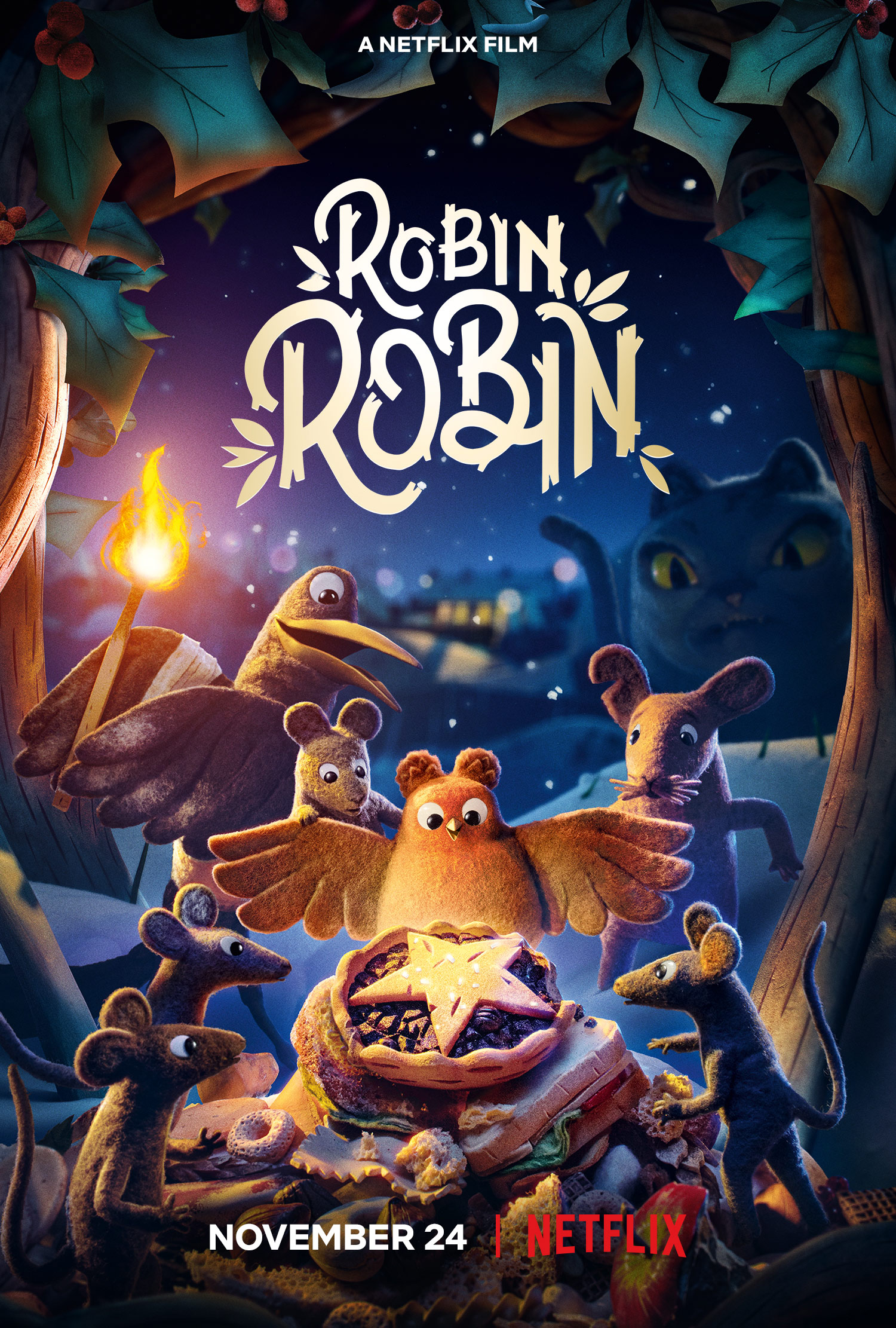
The pandemic. There’s no avoiding it. Did it interrupt your shoot? Had you already started?
Please: Yeah, it massively did.
Ojari: I think we started filming about three weeks or so [before the lockdown]. So we were kind of getting into the stride of the shoot. And it was a very ambitious shoot. We always knew that the ambition of the project and the schedule that we had didn’t quite align, so we knew we were really up against it.
So it was a bizarre situation where you’re just trying to hit full speed, and then everything started and people just started dropping out. But the silver lining for the production, aside from anything else, was that, because we’d filmed enough of it already, we were definitely making it. So there was that security.
But then it gave us about three or four months to [put down our] tools — because there’s so many departments when you’re gearing up to shoot something — and just focus with the story team, an editor, and the musicians. So it was just amazing to be given these few months to go, “Okay, let’s fix these bits; let’s make these bits better.”
So we worked the whole time pretty much purely on the animatic, while the team at Aardman were putting in a lot of work to make the studio Covid-safe — they were expanding all the units. Certain parts of the film were dramatically better because we had this time.
Please: The less good knock-on, I suppose, is that we weren’t able properly to integrate with the team on the level that we usually would in a production. Because everything had to be so business, you know, the minimal communications between the departments.
Ojari: [Aardman studio] Aztec West is not the prettiest of places, but there’s an amazing community there. People have worked there so long, and are ridiculously talented and passionate about what they do. So there’s this lovely community and atmosphere there, and it was really sad to have that formally taken away.
And also knowing that there were risks involved in just coming to work. It was sort of an intense time, but the spirit of everyone and the passion to make the best thing we could make was still there.
Please and Ojari’s answers have been edited for brevity and clarity.
